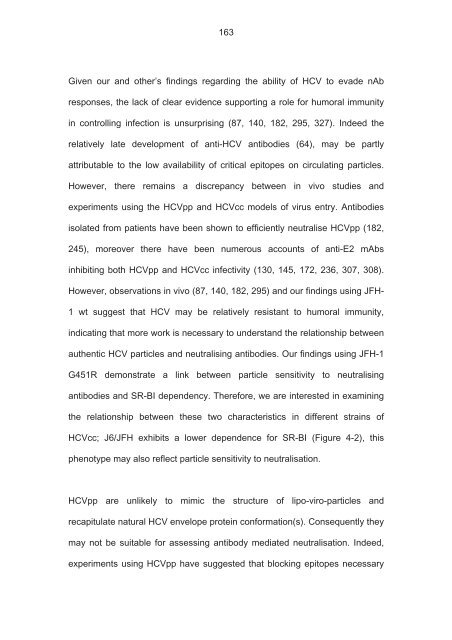The role of scavenger receptor BI in hepatitis - eTheses Repository ...
The role of scavenger receptor BI in hepatitis - eTheses Repository ...
The role of scavenger receptor BI in hepatitis - eTheses Repository ...
You also want an ePaper? Increase the reach of your titles
YUMPU automatically turns print PDFs into web optimized ePapers that Google loves.
163<br />
Given our and other’s f<strong>in</strong>d<strong>in</strong>gs regard<strong>in</strong>g the ability <strong>of</strong> HCV to evade nAb<br />
responses, the lack <strong>of</strong> clear evidence support<strong>in</strong>g a <strong>role</strong> for humoral immunity<br />
<strong>in</strong> controll<strong>in</strong>g <strong>in</strong>fection is unsurpris<strong>in</strong>g (87, 140, 182, 295, 327). Indeed the<br />
relatively late development <strong>of</strong> anti-HCV antibodies (64), may be partly<br />
attributable to the low availability <strong>of</strong> critical epitopes on circulat<strong>in</strong>g particles.<br />
However, there rema<strong>in</strong>s a discrepancy between <strong>in</strong> vivo studies and<br />
experiments us<strong>in</strong>g the HCVpp and HCVcc models <strong>of</strong> virus entry. Antibodies<br />
isolated from patients have been shown to efficiently neutralise HCVpp (182,<br />
245), moreover there have been numerous accounts <strong>of</strong> anti-E2 mAbs<br />
<strong>in</strong>hibit<strong>in</strong>g both HCVpp and HCVcc <strong>in</strong>fectivity (130, 145, 172, 236, 307, 308).<br />
However, observations <strong>in</strong> vivo (87, 140, 182, 295) and our f<strong>in</strong>d<strong>in</strong>gs us<strong>in</strong>g JFH-<br />
1 wt suggest that HCV may be relatively resistant to humoral immunity,<br />
<strong>in</strong>dicat<strong>in</strong>g that more work is necessary to understand the relationship between<br />
authentic HCV particles and neutralis<strong>in</strong>g antibodies. Our f<strong>in</strong>d<strong>in</strong>gs us<strong>in</strong>g JFH-1<br />
G451R demonstrate a l<strong>in</strong>k between particle sensitivity to neutralis<strong>in</strong>g<br />
antibodies and SR-<strong>BI</strong> dependency. <strong>The</strong>refore, we are <strong>in</strong>terested <strong>in</strong> exam<strong>in</strong><strong>in</strong>g<br />
the relationship between these two characteristics <strong>in</strong> different stra<strong>in</strong>s <strong>of</strong><br />
HCVcc; J6/JFH exhibits a lower dependence for SR-<strong>BI</strong> (Figure 4-2), this<br />
phenotype may also reflect particle sensitivity to neutralisation.<br />
HCVpp are unlikely to mimic the structure <strong>of</strong> lipo-viro-particles and<br />
recapitulate natural HCV envelope prote<strong>in</strong> conformation(s). Consequently they<br />
may not be suitable for assess<strong>in</strong>g antibody mediated neutralisation. Indeed,<br />
experiments us<strong>in</strong>g HCVpp have suggested that block<strong>in</strong>g epitopes necessary

















